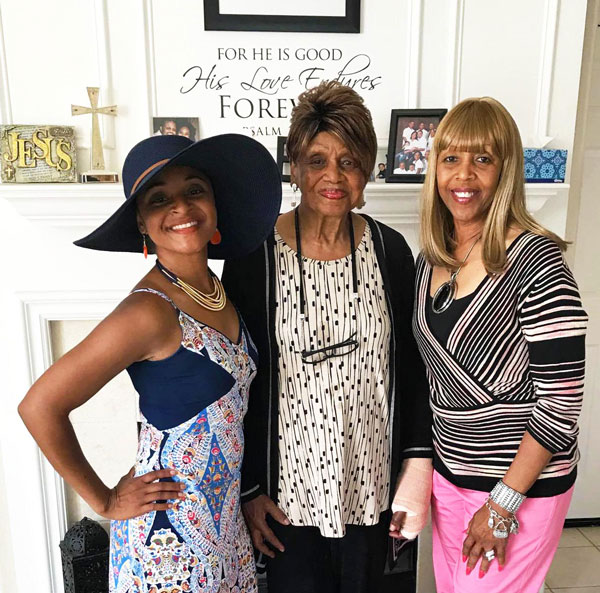
THREE GENERATIONS — Author Jasmine King-Bush (left) with grandmother Vera Harris, whose father helped build the First African Methodist Episcopal Church in Oakland and Jasmine’s mother, Fabienne Freeman, a retired DOE personnel security specialist. (Photo by Phillip Bush)
Black History Month for me was a time to look back at the giants on whose shoulders we now stand. Honoring our history is essential because success isn’t just a single plot point on a timeline. Rather, it’s a vector that can extend from the past into the future.
I trace the start of my personal trajectory to the year 1863 with the construction of the first African-American church in California’s East Bay. My great-grandfather completed much of the woodwork for the historic Oakland church, including building the altar and the tithing box.
Mapping the past
The First African Methodist Episcopal Church was a first in many ways. For 30 years after its founding, it was the only African-American church in the area, and it was the first school for minority kids in Oakland. Initially, other public schools in the city were reserved for white students.
In addition to serving as a meeting space and launching pad for many social and political clubs over the years, the church became a foundation for the faith that has helped to guide my life. I now live in Lathrop, California and attend The Gathering Place in Tracy, where the pastor preaches values I find uplifting: empathy and acceptance of all people.
The next moment in my story happened in 1965 when my grandfather built a house across the street from Bishop O’Dowd High School, also in Oakland. We were the first black family on the block. Looking to increase diversity in their student body, priests from the prestigious school offered my mother and uncle full scholarships to attend.
They both received excellent educations there, as did I and later, my son. The school places a heavy emphasis on analytical thinking and requires extensive volunteerism as well as a college-level thesis before students can be considered for commencement. I do not doubt that the foundational concepts of research, community involvement and commitment to greatness have contributed to the successes that I’ve achieved so far.
Present-day plot points
Fast forward to 2012 — the year I came to Sandia. I started on a temporary contract as a badging specialist. During the second week of my contract, Sandia retiree Dennis Siebers, who was then a manager in the Combustion Research Facility, nudged me toward a permanent staff position as an office management assistant, asking me, “So, why haven’t you applied yet?”
As an OMA, I supported engine combustion research as well as related groups. In 2017, I took on my current role as a financial analyst, supporting systems analysis and engineering, as well as other organizations.
Sandia has been a place of incredible opportunity not only for me, but for my family. My husband Philip Bush also works here in tech support. I encouraged him to join me at Sandia because I knew it would be a place where he could pursue his love for computers and technology, and it has.
Arguably, the most salient data point for this part of the story wasn’t my hire date seven years ago, but 20 years ago when my mother was hired at Lawrence Livermore National Laboratory. As a personnel security specialist, she conducted background checks and clearance interviews. Her career in the DOE labs flourished, so I knew mine could too one day. I hope both of us also will inspire my own children.
Projecting into the future
I am proud of my family’s legacy. Multiple generations of my family overcame their fear of the unknown, trying new things in pursuit of opportunities with exponential benefits. Similarly, I am proud of the effort that Sandia is putting into recognizing and honoring diversity at work. These efforts better enable Sandia to fulfill our mission and foster a culture of inclusivity that will benefit the Labs’ current and future employees.
Black history is an important part of our nation’s history, one not always taught in schools. That’s why I encourage everyone to make some time to participate in Sandia’s diversity and inclusion programs.
Through the recent Black History Month events, we learned about how things we use every day — such as stoplights or the gamma-electric cells in our mobile phones — were brought to market by people like Garrett Morgan and Henry Sampson.
It is perhaps easier not to examine uncomfortable, racially charged aspects of past- and present-day America. But so much is lost, on a corporate, cultural and even a scientific level, when we fail to look at realities that have helped shape this world.
A lot of people say they “don’t see color,” but I disagree with that sentiment. You will miss the full beauty of the rainbow if you don’t see color. Everybody should be recognized for the gifts they bring to the whole. For this reason, last year at the California site I organized Sandia’s first World Cultural Diversity Day, a fun event celebrating ancestral customs, fashion and cuisines of Sandia staff.
I encourage everyone to take a moment to check out the diversity and inclusion initiatives online, learn about Sandia’s plan to encourage diversity through 2020 and beyond, or join one of our campus outreach groups. In these ways, we can ensure that Sandia continues to chart a path toward a brighter, more unified future.